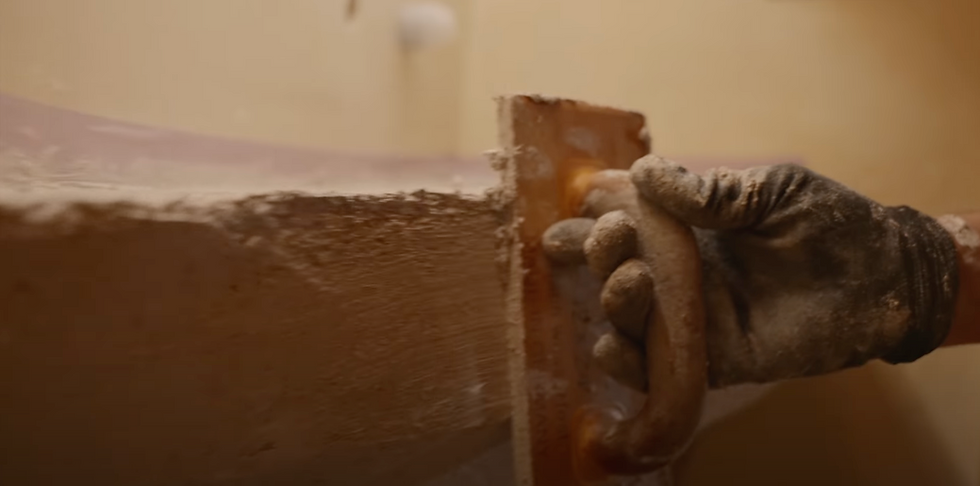Tadelakt finish
- Viviana Fulfuc

- Oct 26, 2023
- 3 min read
Updated: Feb 9, 2024
Timeless materials in design and architecture
As someone who loves architectural interiors, I am a major fan of the minimalist style. The combination of clean lines, bold accents, and light finishes is the perfect way to create a beautiful and functional space. Light sculpting, along with integrated framed views, can create a monumental space which can hardly be matched by a clustering of textures and fixtures. Therefore, I tend to favour white walls and ceilings, with washed beiges and greys to create depth and shadow. I think that light can be enough to shape space, so I always strive to let natural light play a significant role in my designs. Strategically located lighting, combined with the daylight glow, can transform the blandest space and turn it into a mesmerising place.

Recently, I fell in love with a material that seemed to provide a delicate and clean finish while maintaining the robustness required for a wide range of applications: #tadelakt. This timeless material caught my eye when I first discovered it in Mykoniannian architecture, so I was curious to find out more about it.
Although not native to Greece, tadelakt has been used in various parts of the country, primarily in interior design. Greece's historical and architectural connections to the Mediterranean and North African regions, where tadelakt is traditionally used, have influenced the adoption of this marvellous technique into Hellenic architecture and design. Due to its sculptural quality, this material blends brilliantly with the Cycladic architecture, echoing the whitewashed organic shapes that embrace the rocky hills.
The curvilinear shapes are reflected in the use of tadelakt finish on the walls, floors, and ceilings, creating a seamless transition between the three-dimensional planes with soft, rounded corners.
The feeling of unity is emphasised by using tadelakt to form vanities and shower enclosures, which adds to the aesthetics and promotes the safety and well-being of its occupants. This is due to the antibacterial and antimicrobial properties, which help prevent the growth of bacteria and other microorganisms. Although more labour-intensive, this is an excellent and stylish alternative to tiles or vinyl, thanks to its hydrophobic qualities, when used in combination with an olive oil soap and water solution. The stearic acid in soap chemically reacts with the lime to form calcium stearate, which results in a surface that is both water and scratch-resistant as well as hard and durable.
This is a laborious process, reflected in the price, highly dependent on the complexity of the works, starting from £150/m². Despite being this pricey, it may balance the cost by reducing the number of trades on-site, since it has multiple applications.
The application process requires high skill and attention to detail to ensure a flawless result. Like any other system, proper workmanship and maintenance are critical to ensure the longevity and functionality of the tadelakt surfaces. This can be applied to almost any substrate, such as brick, concrete blocks, strawbale walls, and even ceramics. Still, a backer board or waterproof panel is better suited for wet areas to control any moisture passing through. Tadelakt can be applied to the substrate directly or on a fibre-reinforced base in thin, 2mm layers and mixed with pigments to achieve the desired hue.
Much like plastering, a mesh is embedded in the surface during application to prevent cracking from shrinkage. Traditionally, this plastering technique is completed by rubbing a hard, polishing pebble stone to compress the lime and seal any pores to make the surface completely waterproof. To safeguard the surface of the tadelakt, a final layer of wax sealer may be applied.
This is a laborious process, reflected in the price, highly dependent on the complexity of the works, starting from £150/m². Despite being this pricey, it may balance the cost by reducing the number of trades on-site, since it has multiple applications. Not to mention that this is a greener alternative when compared to similar cement-based finishes in terms of carbon emissions. A natural insulator, tadelakt can also improve the thermal performance of the room it’s been applied to, while being kind to the environment since it uses minimal energy in production and avoids harmful chemicals, such as synthetic or hazardous cleaning substances.
So, next time you want to add texture to your modern space, look no further than tadelakt! This versatile and beautiful finish is perfect for those who want to combine contemporary and traditional design elements with a bohemian twist. Incorporating tadelakt surfaces into your design is the ideal way to create a genuinely distinctive and #mpressive space that will leave anyone who enters it in awe.







Комментарии